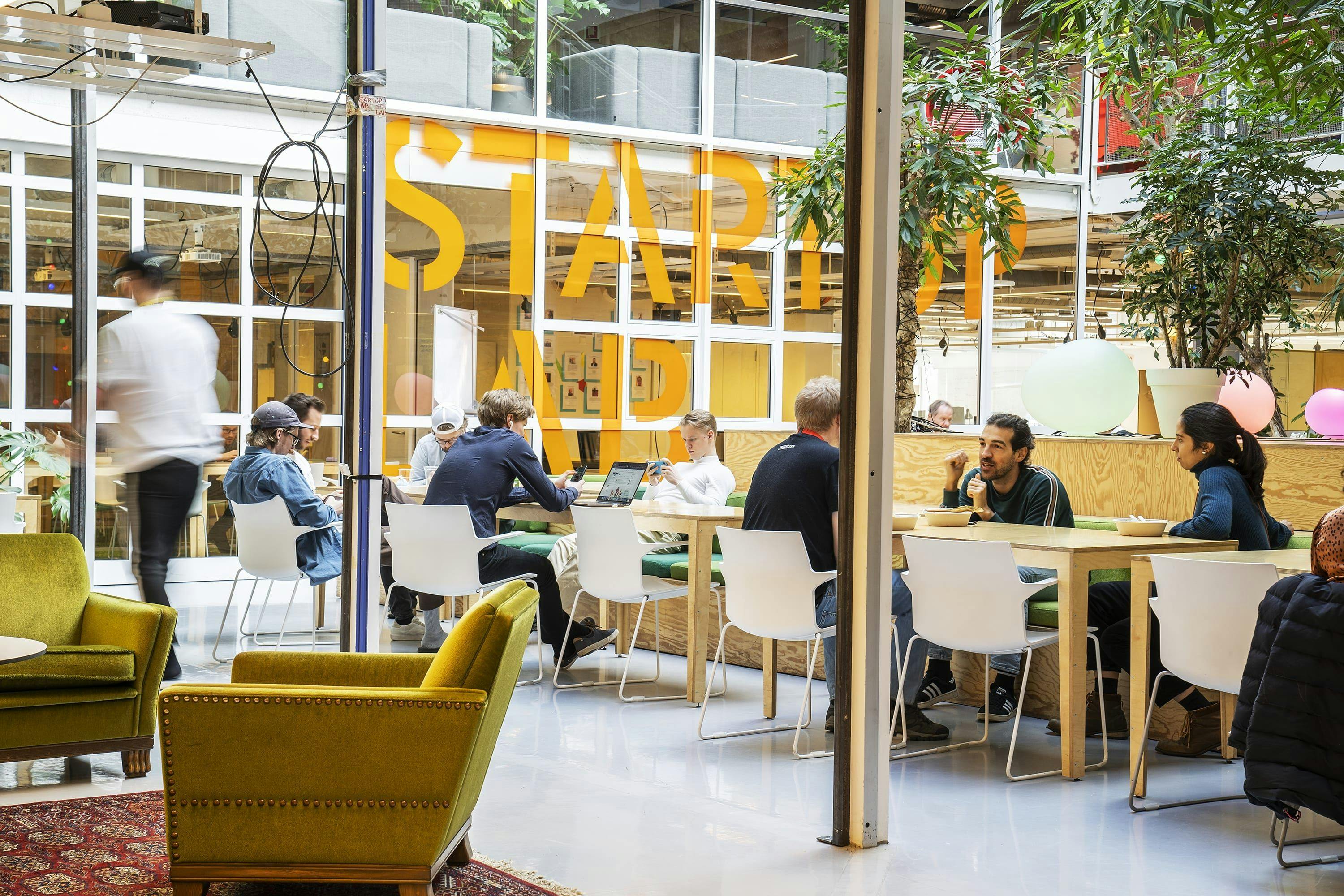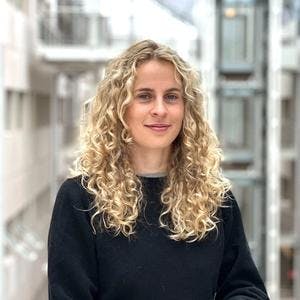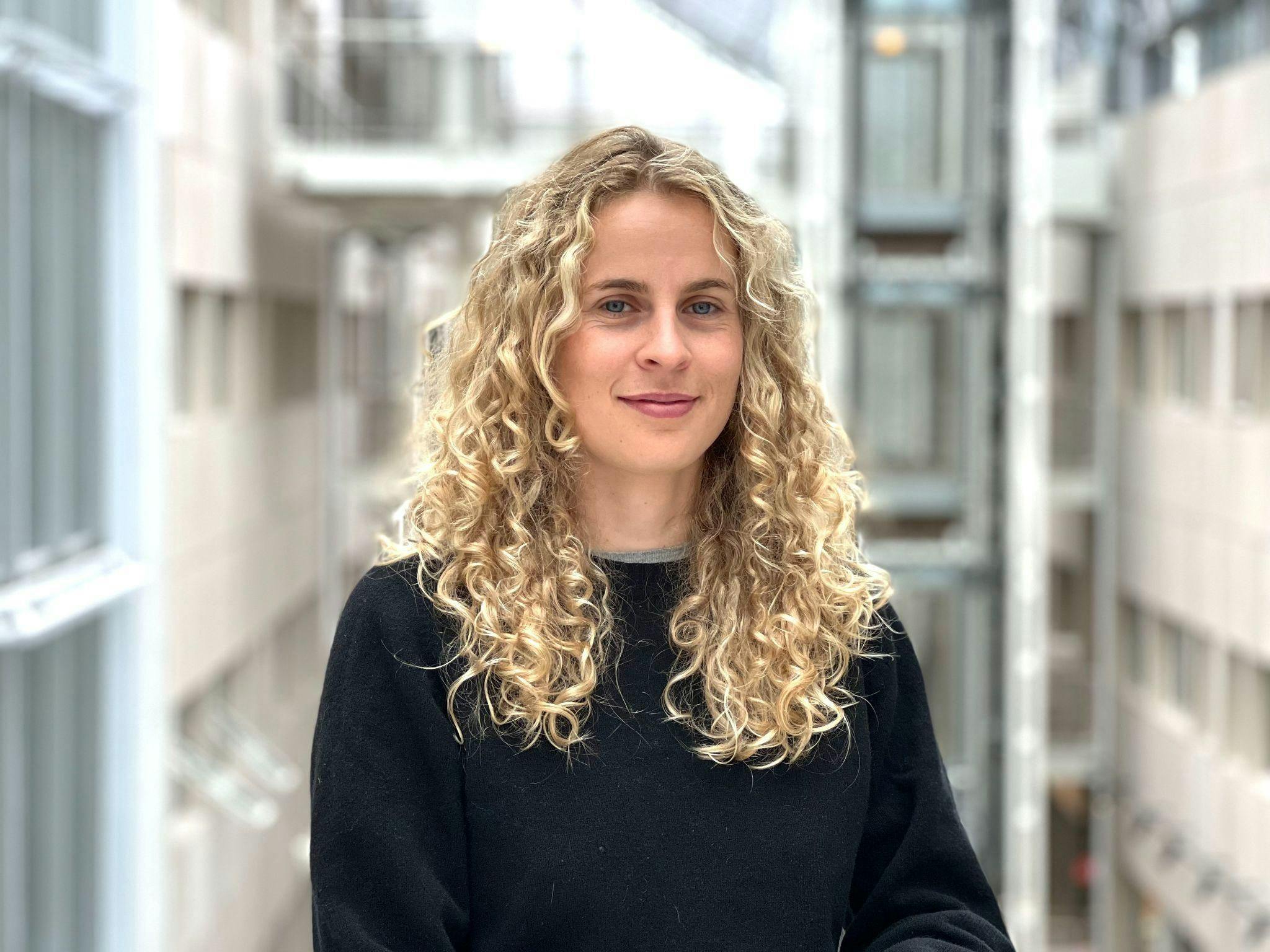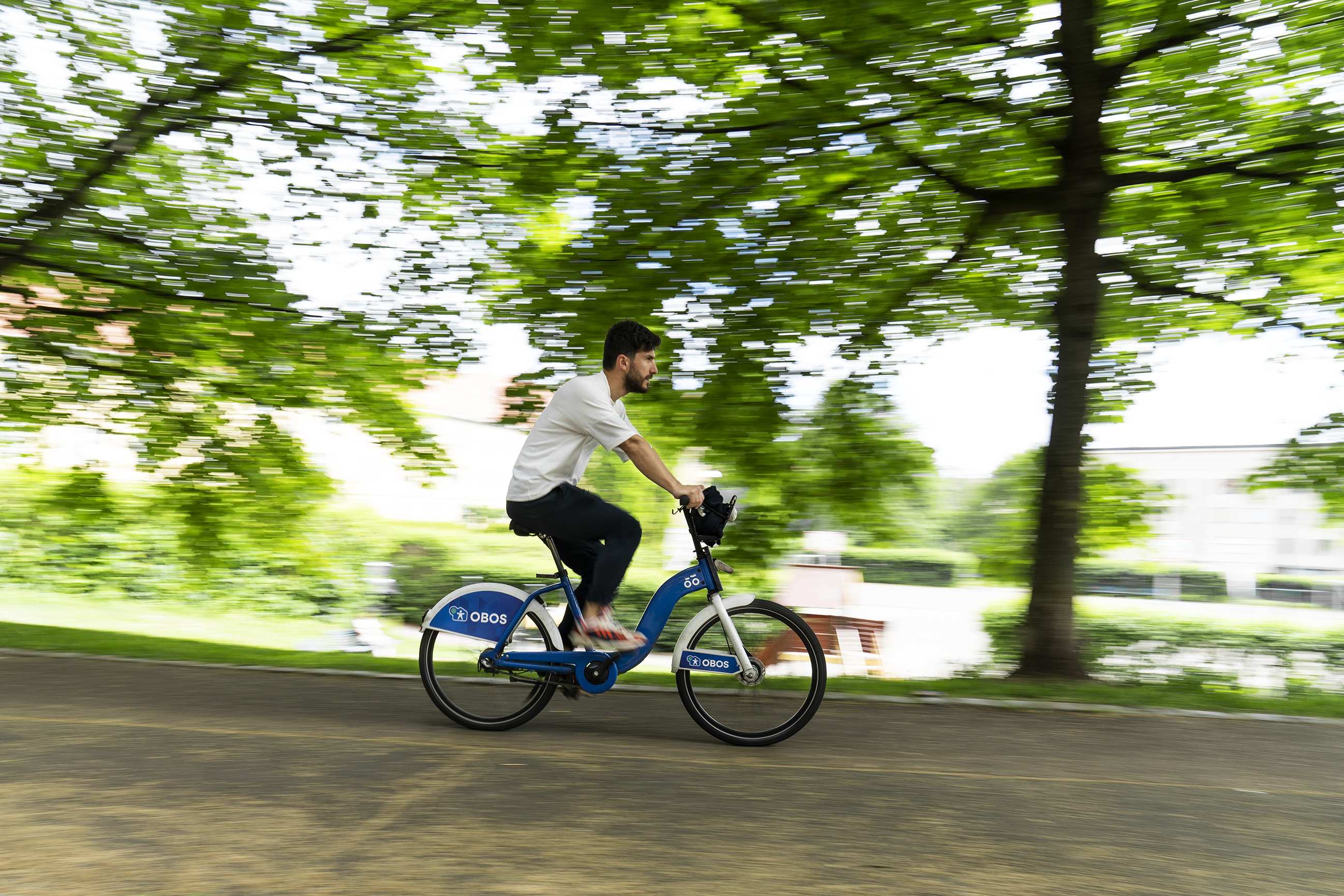 Visit AirThings
Visit AirThingsFrom strategy to action

The City of Oslo is a major engine for innovation with annual procurements worth NOK 30 billion and has a clear commitment to reaching the United Nations Sustainable Development Goals (SDGs), Without innovation, city development will stagnate and lose traction toward a sustainable future.
Fortunately, Oslo’s ambitious goals to alleviate poverty, combat inequality and address climate change by 2030 are within reach, and the fast-growing startup ecosystem is developing solutions that can accelerate progress toward a resilient society and sustainable economy.
This guide is your shortcut to opportunities, programs and tools for public-private collaboration and innovation.

Oslo is ranked no. 1 of 50 medium-sizes cities globally for government appetite to adopt new technologies ("Oslo State of the City 2022").
Startup vs Scaleup
When we talk about "growth companies," we are referring to startups and scaleups. Both are excellent sources of innovative solutions for the city and, at the same time, create jobs and grow the economy as they scale in Norway and globally. Here is an overview of when a startup becomes a scaleup.
Startup
A startup is a company with 1–10 employees and has a business model forecasting rapid market expansion. Startups often post an operating loss double their accumulated revenues in the first two to five years (J-curve for companies) or have increased their share capital by at least NOK 100,000 since the start (capital intensive).
Scaleup
A scaleup business (the phase after startup) is a company with 10 or more employees that is growing annually by at least 20 percent and has an innovative solution to an important global problem. These companies are knowledge-based, innovative (qualifying for SkatteFUNN), have increased their share capital by at least NOK 1 million, or have shares in venture capital/investment funds.
Why Oslo’s startup ecosystem matters
To maintain the current welfare state Norwegian exports need to double by 2040. This won’t happen without expanding the ecosystem for growth companies (startups and scaleups). The startup ecosystem stimulates sustainable growth by attracting knowledge and capital and providing the infrastructure that helps new ideas emerge.
Oslo's ecosystem has grown substantially in recent years. Today, there are about 2,200 startups and 188 scaleups (Menon). Many of these growth companies are well known in Norway and internationally.
The ecosystem has doubled in value from 2021 to 2022. Valued at USD 2.6 billion, it ranks 11th among its 25 ‘emerging ecosystem’ peers. The city ranks high for specialization in future-proof industries and is in the top 25 percent of its peer group for relative innovation specialization in Clean and GreenTech, DeepTech and Disruptive Technologies, and FinTech and Financial Services. Specializations in BioTech, Pharma and Life Sciences are also growing. (“Oslo: State of the City 2022”).
The innovation ecosystem
Many of the solutions the city needs to solve critical challenges -- from healthcare and life sciences to environment and education -- are already available or being developed by Norwegian growth companies. For an overview of all the startups and scaleups in Oslo, visit the Dealroom database.
Unicorns
In the past five years, Oslo has topped the charts for growth in unicorns, venture capital investment and high-value exits. Oslo is now home to six “unicorns” -- startups valued over USD 1 billion each.






Public-private success stories
Here is a look at some of Oslo’s many startups and scaleups that provide solutions to the public sector.
 Visit AirThings
Visit AirThings
Diffia is boosting efficiency in the health sector with a new cloud application.


Ulrikke Lien
CEO, Sensorita
Established: 2020
Sector: Waste management
We use sensors to streamline waste management and give waste companies total control over their container fleet.
We are looking for a suitable construction site to run a system demo next spring.

Larvik is investing in digital home follow-up.


Ieva Sibilla Strupule
CEO, Material Mapper AS
Established: 2020
Sector: Construction technology
We facilitate all processes for the purchase, sale and reuse of building materials. Our digital platform shows how, where, when and what quantity of building materials will become available from building demolition, renovation and newbuild projects.
We want to help Oslo achieve ambitious zero-emission goals and cut construction waste.

This startup is developing sustainable concrete. Now Snøhetta will take this invention out into the world.


Martin Bogstrand
CCO, Vilje Bionics
Established: 2021
Sector: Medical technology, orthopedics & prosthetics, assistive devices
A motorized arm exoskeleton for people with arm impairments. The assistive device enables its users to perform daily activities like eating and drinking.

Unacast is investing in Norway: Will make cities better by harnessing the power of location data to monitor how people move around.
How Oslo and growth companies can collaborate

Even when the public and private sectors are working to solve the same challenges, there can be quite a gap when it comes to structure, revenue, risk and time to market. Conventional procurement processes favor business as usual rather than innovation.
To narrow the gap and reduce the perceived risk often associated taking on new solutions, there are a number of opportunities and programs promoting public-private R&D, design, and commercialization. They facilitate testing and implementation of innovative solutions without risk or strain on time and resources.
City entities can test a particular solution through a pilot project, initiate a national competition, engage in market dialogue through an innovative procurement, enter an innovation contract , or launch a standard procurement process. These opportunities are described in more detail in the section: "Pilot programs, procurement and other opportunities."
If, for example, a city department wants to test a solution from a particular startup, it is possible to bypass procurement processes and apply directly to SmartOslo. Under the SmartOslo scheme, a city entity can partner with a startup to test solutions in health, digitalization, mobility and climate change. The scheme provides matching grants between NOK 50,000 and NOK 1 million for pilot projects and has a rolling application deadline.
Getting innovation off the ground
Define the need
Whether you want to make small or large changes, innovation starts with a clearly defined need, opportunity or problem statement. This describes how things are done today, the desired outcome, and the...
Problem / opportunity analysis
Describe the problem you’d like to solve or the opportunity you see. In what respect is the problem/opportunity relevant for your organization? On a scale of 1–10, how familiar are you with the prob...
Frame the challenge
After you have assessed the need or opportunity, how do you create an innovation challenge that leads to a pilot project or innovative procurement? The key is to keep your focus on the challenge, rath...
Explore the market
How do you go about identifying and meeting relevant startups that can help solve your challenge? Maybe you are already getting flooded with phone calls from startups eager to pitch their solutions. H...
Managing risk
Don’t let a fear of risk keep you from testing an innovative solution that could be game-changing for your industry. If you set up a pilot project through a support scheme like SmartOslo or stay below the 100K purchasing threshold, you can team up with any startup you want and test their solution without going through a formal procurement process.
In any case, it is good to remember the basic rules for managing risk when interacting with the market:
- You can talk to anybody. One-to-one phone calls and meetings with startups are OK!
- Don’t give anyone an unfair advantage.
- Don’t modify an upcoming or current tender process to fit a particular company.
If a tender is in the works and you meet with or take a call with a startup, write down the points covered and don’t offer any information that would give the company an unfair advantage. You need to be aware of procurement rules and regulations specific to your project and organization to ensure that you don’t unintentionally disqualify anyone from the procurement process.
Also, don’t modify a tender, whether in draft form or final, to fit a specific company. Make sure that the tender is drafted in accordance with your needs, is solution-oriented and not overly prescriptive, so that a broader pool of startups can meet the requirements.
If you would like to talk to one or more companies to learn about the market, it is also possible (but not required) to give advance notice and open the opportunity to everyone. You can announce digital/physical meetings on Doffin and include questions for interested parties to prepare. Written responses from startups are informational and not legally binding.
If you find a supplier that is the only one offering a solution that fits your particular need, you can go straight to purchase, but you have to be able to prove that there is no other option in the European Economic Area (EEA). Sometimes it is difficult to prove that something does not exist. In such cases, you can apply a so-called voluntary ex ante notice (“intensjonskunngjøring”). Post your intent to procure from that supplier on Doffin or TED for 10 days and proceed with the purchase if there is no complaint.
Your contract may also qualify for an R&D Exemption (FoU unntak) if the main element in the contract is research and development (R&D). This means that over 50 percent of the contract involves the generation of new knowledge.
It is always a good idea to talk with your internal procurement specialist and clarify procurement rules and regulations for the project you have in mind as rules may vary for different funding thresholds.
Procurement levels
The national procurement threshold for municipalities, counties and other public entities is NOK 1.3 million. All contracts for goods or services above the threshold must go to tender by way of a formal contract announcement. Norway follows EEA threshold values. See updated EEA threshold values.
Under 100K NOK
The city can purchase the solution directly from the startup.
100K–1.3M NOK
The city entity is required to invite a minimum of 3 bidders to compete for the tender.
Over 1.3M NOK
The project must be announced on Doffin, the national public procurement database.
Pilot programs, procurement and other opportunities
Where to go with an idea, need or challenge

You don’t have to go it alone! If you have an idea for an innovative solution you would like to test in the city, you can reach out directly to the organizations that support innovation projects and procurements. Take a look at the websites listed below to see which are best suited to your needs, then contact the relevant organizations to walk through requirements. Experts are available to answer your questions and get you started on the right path.
Navigating the City of Oslo
The City of Oslo has both municipal and county functions and is administered on the basis of a parliamentary-style governance model. The City government is accountable to the City Council in the same way that the national government is accountable to the Norwegian parliament (Storting). Here is the organization chart in Norwegian. Details on the various entities are provided in English in the following section.

Discover city innovation hotspots
The Governing Mayor’s Office
Byrådslederens kontor
The Governing Mayor’s Office is the secretariat for the political leadership and has overall responsibility for the further development of Oslo’s political and administrative governance, as well as leadership and skills development at the strategic level. The office has group-wide responsibility and duties in the City of Oslo’s administration which include:
- Overarching coordination and development of the City’s participation in international and regional partnerships and collaborations.
- The regulations database contains the City of Oslo’s regulations and authorizations granted by the City Council, the City Government and the individual departments.
Governing Mayor’s Office – Agencies
- Emergency Planning Agency (Beredskapsetaten)
- City Attorney (Kommuneadvokaten)
- City Hall General Services (Rådhusets forvaltningstjeneste)
Department of Finance
Finansbyråden
The Department of Finance coordinates how money is managed and spent by the City of Oslo.
Agencies
- Tax Collection Office (Innkrevingsetaten)
- Agency for Improvement and Development (Utviklings- og kompetanseetaten) UKE is the city's in-house provider of services relating to IT, procurement, organizational development, payroll and accounting. The Agency provides residents with efficient, smarter, more coordinated and universally accessible services.
Department of Business Development and Public Ownership
Byrådsavdeling for næring og eierskap
Underlying agencies
Department of Urban Development
Underlying agencies
Department of Environment and Transport
Byrådsavdeling for byutvikling
The Department of Environment and Transport is responsible for following up the development and delivery of services relating to climate and the environment; cycling; waste management and recycling; water supply and sewage treatment; roads, transport and parking; fire prevention, fireplaces and chimney sweeping; hiking and outdoor leisure pursuits; bathing places and temperatures; parks and trees; public transport.
Agencies
- Agency for Fire and Rescue Services (Brann- og redningsetaten)
- Agency for Urban Environment (Bymiljøetaten). The agency manages shared spaces such as roads, squares, parks, recreational areas, sports facilities, the Oslo woods and inner Oslofjord. They also are responsible for air, water and soil quality, and noise abatement. See all announcements.
See focus areas and projects for cycle paths, roads and squares, the environment and water, parks and sports facilities and the “hjertesone” road safety scheme around schools. - Fornebu Metro Line (Fornebubanen) The Fornebu Metro Line is a partnership between the City of Oslo and Viken County Council.
- Agency for Climate (Klimaetaten). See updated Reports and documents
- Agency for Waste Management (Renovasjons- og gjenvinningsetaten).
- Agency for Water and Wastewater Services (Vann- og avløpsetaten)
Department of Culture, Sports and Volunteer Activities
This department is responsible for the development of the city’s libraries, culture schools and sports facilities, the new Munch Museum and several grant schemes to safeguard a vibrant cultural life. It also is responsible for church and religious communities, burials, the city archive, film and media policy, and has a focus on volunteer activities.
Agencies
- The Agency for Cemeteries and Burials (Gravferdseteten). The agency ensures that Oslo’s residents are buried with dignity and respect on the basis of their religious faith or philosophical views.
- The Agency for Cultural Affairs (Kulturetaten) manages grants for artistic and cultural initiatives, children’s holiday camps, volunteer organizations for children and young people, and volunteer music performances. The Agency also includes Oslo kulturskole (Oslo culture schools), Oslo byarkiv (Oslo City Archive), Oslo Ladegård (cultural centre), Popsenteret (museum of popular music), Øvingshotellet (rehearsal space), Rommen scene (theater), Vigelandmuseet (Vigeland Museum), the artworks in Vigelandsparken, Oslobiennalen (a biennial arts festival) and Oslo kulturnatt (annual one-day cultural event).
- The Munch Museum (Munchmuseet) houses a large collection of works by Edvard Munch and contemporary artists.
Department of Education
Agencies
- Utdanningsetaten. The Education Agency is responsible for the operation, development, follow-up and guidance of educational activities within the laws, frameworks and guidelines adopted by the national and municipal authorities.
Department of Employment, Integration and Social Services
Byråd for arbeid, integrering og sosiale tjenester
Agencies
- The Agency for Child and Family Welfare Services (Barne- og familieetaten) is responsible for ensuring that services meet the City's needs and are high quality. When the Child Welfare Service has determined that a child needs to be relocated from their home, the Agency assists in finding the solution that the Child Welfare Service deems appropriate.
Department of Health, Aging and Municipal Services
Byråd for helse, eldre og innbyggertjenester
Underlying agencies
- The Agency for Health (Helseetaten) is responsible for the provision of emergency medical services, dental health services, public health services and tasks relating to social care services and psychiatric services. They are also responsible for operating and developing the city's professional systems in the health and care sectors.
- Oslo Origo is the City's digitalization agency, working to improve daily life of Oslo’s residents through the development of personal, targeted and proactive digital citizen services. By working holistically and with a long-term perspective in selected service areas, the agency simplifies employees’ work processes and improves professional systems to better meet residents’ needs.
- Together with the Department of Education and the Education Agency, Origo is currently exploring opportunities to improve communication with parents across schools, preschools and after-school schemes.
- The Nursing Home Agency (Sykehjemsetaten). The purpose of the Nursing Home Agency is to provide the best possible services to those in need of round-the-clock care, rehabilitation and social care, within the political, financial and administrative framework adopted by the City of Oslo.
City districts





